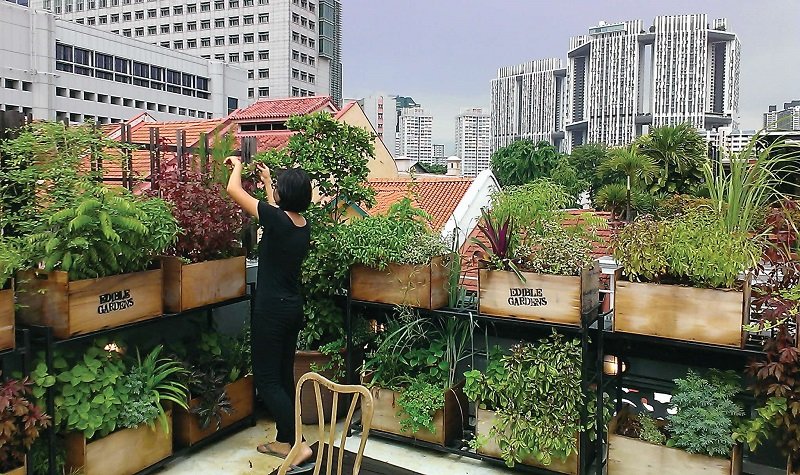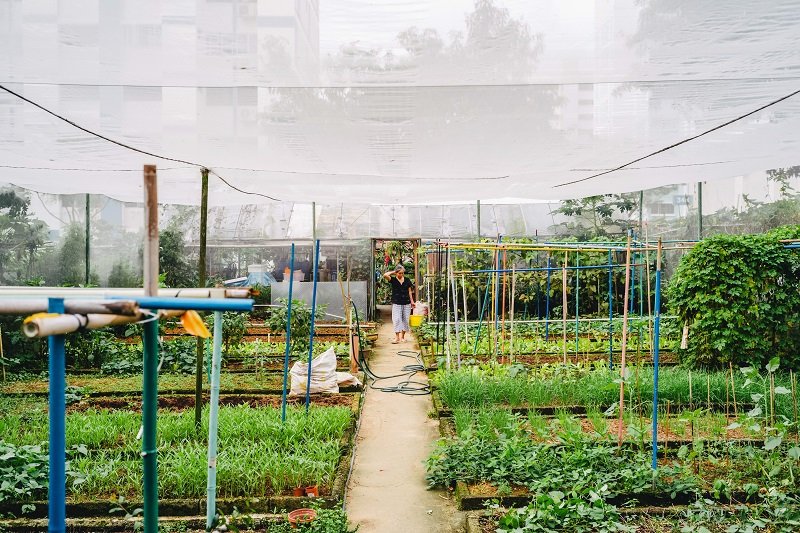Farming not only brings people together, but can also address health and social challenges, celebrate local and diverse cultures and much more. Urban Farmer and Founder of Edible Garden City, Bjorn Low, dreams of future urban farms becoming a more integral part of our landscape and community.

Edible Garden City’s rooftop gardens not only help to supply produce to nearby restaurants, but they can also help educate the public about urban farming. Image: Edible Garden City.
How is urban farming helping people to connect more with one another?
When we are tending to our gardens and farms in our neighbourhoods, we are also sharing knowledge, stories, and memories. Some of the seniors will share about their kampung days and past experiences with gardening or farming, which helps us understand more of our past and to feel more connected to one another.
The physical location where farming takes place is also important as it reinforces a stronger sense of place and identity for residents and communities. When I worked with various agricultural communities in other cities, they’ve always organised festivals and activities around harvesting periods. This helps to further strengthen the community spirit and culture.
In the last 10 years, you have experimented with different forms and types of farming on rooftops, as pop-ups or within neighbourhoods. What is one important consideration to bear in mind when designing and curating urban farms for communities?
Bjorn: A lot of our commercial farms today may not be easily accessible and spaces within may also not be easy to navigate. For farming to become a more integral part of our community and daily lives, we should design and include spaces within the farm for the community.

From the first community garden in Tampines that I was involved in, to setting up pop-up farms on rooftops such as at People’s Park Complex and taking over shophouses, we’ve always tried to ensure that these farming spaces are easily accessible, and we’ve actively and regularly engaged the community.
You were involved in the Ah Gong Farm project at the York Hill estate that used farming to help enhance some of the elderly residents’ wellbeing. Tell us more about the project.
Bjorn: The Ah Gong project was initiated in 2016 as an experiment under the Kreta Ayer Family Services to explore how farming could help enhance the well-being of elderly men living in the York Hill area in Kreta Ayer, Chinatown. Social workers in the area had observed that the elderly men living in the area in particular tended to detach themselves from the community.
The pilot effort was done over a six-week period where about 14 elderly men took part. A small space was set aside for farming. They were taught some basic farming skills, did some hands-on farming work, and learnt some social and life skills as well. One of the men who took part was very quiet at the start and did not make eye contact when he spoke with others. But by the end of the six weeks, he became chattier and more sociable.
Many of those who took part saw reductions in their blood pressure. The physical work of farming and being in the outdoors had helped to energise them and given them a greater purpose and focus. In the National Parks Board’s study of the value of therapeutic gardens and horticulture, their study reinforced the benefits of being in nature and the cultivation and harvesting of plants in helping us to relax and reduce our stress levels.
There was the social aspect too where the men were encouraged to open up more and socialise with one another. This helped to improve their social skills and raise their self-esteem.
Because of the positive response and outcome from this pilot effort, the social enterprise, the Goodlife!, has gone on to adapt from this project and carry out more of such similar efforts for the elderly communities in other neighbourhoods.
What do you hope to see for the future of urban farming in communities?
Bjorn: I hope to see urban farms become even more common and prevalent within our communities, much like we how we have polyclinics and supermarkets in our neighbourhoods.

A local farm and garden in Bukit Gombak.
I see farming as being able to address social and mental challenges. It could play a critical role in our health system. In future, someone who has mild depression could be prescribed a course of a hands-on farming experience to address his or her health issues instead of being prescribed medicine to take.
We can also explore how some of our farms can serve many other purposes and functions. The United African Farm in Melbourne, Australia, is a community-run project that grow crops of cultural significance and connection to their roots. They celebrate the African migrant culture, diversity, and food. It is such an interesting and fun place to be in.
They have a range of activities, from farm production to community gardening, cultural excursions and even capacity building efforts. We could explore such interesting and creative models of farming in future.
Shaping an endearing city: “When enough is enough” – Bjorn Low was featured in the Singapore Pavilion for the 2023 18th International Architecture Exhibition – La Biennale di Venezia. Based on the theme of “When is enough, enough”, the pavilion explores the more intangible qualities of designing and shaping a more endearing city, in creating connections, influencing change and providing more inclusive spaces. For more information about the Singapore Pavilion, go to https://singaporepavilion.sg/
Source: https://www.ura.gov.sg/Corporate/Resources/Ideas-and-Trends/Bonding%20through%20farming


